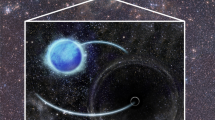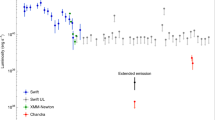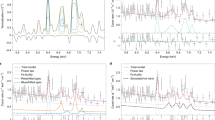Abstract
There are two proposed explanations for ultraluminous X-ray sources1,2 (ULXs) with luminosities in excess of 1039 erg s−1. They could be intermediate-mass black holes (more than 100–1,000 solar masses,  ) radiating at sub-maximal (sub-Eddington) rates, as in Galactic black-hole X-ray binaries but with larger, cooler accretion disks3,4,5. Alternatively, they could be stellar-mass black holes radiating at Eddington or super-Eddington rates2,6. On its discovery, M 101 ULX-14,7 had a luminosity of 3 × 1039 erg s−1 and a supersoft thermal disk spectrum with an exceptionally low temperature—uncomplicated by photons energized by a corona of hot electrons—more consistent with the expected appearance of an accreting intermediate-mass black hole3,4. Here we report optical spectroscopic monitoring of M 101 ULX-1. We confirm the previous suggestion8 that the system contains a Wolf-Rayet star, and reveal that the orbital period is 8.2 days. The black hole has a minimum mass of 5
) radiating at sub-maximal (sub-Eddington) rates, as in Galactic black-hole X-ray binaries but with larger, cooler accretion disks3,4,5. Alternatively, they could be stellar-mass black holes radiating at Eddington or super-Eddington rates2,6. On its discovery, M 101 ULX-14,7 had a luminosity of 3 × 1039 erg s−1 and a supersoft thermal disk spectrum with an exceptionally low temperature—uncomplicated by photons energized by a corona of hot electrons—more consistent with the expected appearance of an accreting intermediate-mass black hole3,4. Here we report optical spectroscopic monitoring of M 101 ULX-1. We confirm the previous suggestion8 that the system contains a Wolf-Rayet star, and reveal that the orbital period is 8.2 days. The black hole has a minimum mass of 5 , and more probably a mass of 20
, and more probably a mass of 20 −30
−30 , but we argue that it is very unlikely to be an intermediate-mass black hole. Therefore, its exceptionally soft spectra at high Eddington ratios violate the expectations for accretion onto stellar-mass black holes9,10,11. Accretion must occur from captured stellar wind, which has hitherto been thought to be so inefficient that it could not power an ultraluminous source12,13.
, but we argue that it is very unlikely to be an intermediate-mass black hole. Therefore, its exceptionally soft spectra at high Eddington ratios violate the expectations for accretion onto stellar-mass black holes9,10,11. Accretion must occur from captured stellar wind, which has hitherto been thought to be so inefficient that it could not power an ultraluminous source12,13.
This is a preview of subscription content, access via your institution
Access options
Subscribe to this journal
Receive 51 print issues and online access
$199.00 per year
only $3.90 per issue
Buy this article
- Purchase on Springer Link
- Instant access to full article PDF
Prices may be subject to local taxes which are calculated during checkout



Similar content being viewed by others
References
Fabbiano, G. The hunt for intermediate-mass black holes. Science 307, 533–534 (2005)
Gladstone, J. The sub-classes of ultraluminous X-ray sources. Preprint at http://arXiv.org/abs/1306.6886 (2013)
Miller, J. et al. A comparison of intermediate mass black hole candidate ultraluminous X-ray sources and stellar mass black holes. Astrophys. J. 614, L117–L120 (2004)
Kong, A. K. H., Di Stefano, R. & Yuan, F. Evidence of an intermediate-mass black hole: Chandra and XMM-Newton observations of the ultraluminous supersoft X-ray source in M101 during its 2004 outburst. Astrophys. J. 617, L49–L52 (2004)
Liu, J. F. & Di Stefano, R. An ultraluminous supersoft X-ray source in M81: an intermediate-mass black hole? Astrophys. J. 674, L73–L77 (2008)
Gladstone, J. et al. The ultraluminous state. Mon. Not. R. Astron. Soc. 397, 1836–1851 (2009)
Mukai, K., Still, M., Corbet, R., Kuntz, K. & Barnard, R. The X-ray properties of M101 ULX-1 = CXOKM101 J140332.74+542102. Astrophys. J. 634, 1085–1092 (2005)
Liu, J. F. Multi-epoch multi-wavelength study of an ultraluminous X-ray source in M101: the nature of the secondary. Astrophys. J. 704, 1628–1639 (2009)
McClintock, J. & Remillard, R. in Compact Stellar X-ray Sources (eds Lewin, W. & van der Klis, M. ) 157–213 (Cambridge Astrophysics Series No. 39, Cambridge Univ. Press, 2006)
Esin, A. A., McClintock, J. E. & Narayan, R. Advection-dominated accretion and the spectral states of black hole X-ray binaries: application to nova Muscae 1991. Astrophys. J. 489, 865–889 (1997)
Remillard, R. A. & McClintock, J. E. X-ray properties of black-hole binaries. Annu. Rev. Astron. Astrophys. 44, 49–92 (2006)
Rappaport, S., Podsiadlowski & Pfahl, E. Stellar-mass black hole binaries as ultraluminous X-ray sources. Mon. Not. R. Astron. Soc. 356, 401–414 (2005)
Linden, T. et al. The effect of starburst metallicity on bright X-ray binary formation pathways. Astrophys. J. 725, 1984–1994 (2010)
Roberts, T. P. et al. (No) dynamical constraints on the mass of the black hole in two ULXs. Astron. Nachr. 332, 398–401 (2011)
Cseh, D., Gris’e, F., Corbel, S. & Kaaret, P. Broad components in optical emission lines from the ultraluminous X-ray source NGC 5408 X-1. Astrophys. J. 728, L5–L9 (2011)
Hillier, D. J. & Miller, D. L. The treatment of non-LTE line blanketing in spherically expanding outflows. Astrophys. J. 496, 407–427 (1998)
Schaerer, D. & Maeder, A. Basic relations between physical parameters of Wolf-Rayet stars. Astron. Astrophys. 263, 129–136 (1992)
Crowther, P. A. Physical properties of Wolf-Rayet stars. Annu. Rev. Astron. Astrophys. 45, 177–219 (2007)
Prestwich, A. H. et al. The orbital period of the Wolf-Rayet binary IC 10 X-1: dynamic evidence that the compact object is a black hole. Astrophys. J. 669, L21–L24 (2007)
Silverman, J. M. & Filippenko, A. V. On IC 10 X-1, the most massive known stellar-mass black hole. Astrophys. J. 678, L17–L20 (2008)
Carpano, S. et al. A 33 hour period for the Wolf-Rayet/black hole X-ray binary candidate NGC 300 X-1. Astron. Astrophys. 466, L17–L20 (2007)
Crowther, P. A. et al. NGC 300 X-1 is a Wolf-Rayet/black hole binary. Mon. Not. R. Astron. Soc. 403, L41–L45 (2010)
Steiner, J. F., McClintock, J. E., Remillard, R. A., Narayan, R. & Gou, L. J. Measuring black hole spin via the X-ray continuum-fitting method: beyond the thermal dominant state. Astrophys. J. 701, L83–L86 (2009)
Miller, M. C. & Hamilton, D. P. Production of intermediate-mass black holes in globular clusters. Mon. Not. R. Astron. Soc. 330, 232–240 (2002)
Portegies Zwart, S. F., Baumgardt, H., Hut, P., Makino, J. & McMillan, S. L. W. Formation of massive black holes through runaway collisions in dense young star clusters. Nature 428, 724–726 (2004)
Blecha, L. et al. Close binary interactions of intermediate-mass black holes: possible ultra-luminous X-ray sources? Astrophys. J. 642, 427–437 (2006)
Madhusudhan, N. et al. Models of ultraluminous X-ray sources with intermediate-mass black holes. Astrophys. J. 640, 918–922 (2006)
Middleton, M. J. et al. Bright radio emission from an ultraluminous stellar-mass microquasar in M31. Nature 493, 187–190 (2013)
Barnard, R., Clark, J. S. & Kolb, U. C. NGC 300 X-1 and IC 10 X-1: a new breed of black hole binary? Astron. Astrophys. 488, 697–703 (2008)
Mohamed, S. & Podsiadlowski Mass transfer in Mira-type binaries. Balt. Astron. 21, 88–96 (2011)
Freedman, W. et al. Final results from the Hubble Space Telescope key project to measure the Hubble Constant. Astrophys. J. 553, 47–72 (2001)
Kong, A. K. H., Rupen, M. P., Sjouwerman, L. O. & Di Stefano, R. in Proc. Papers 22nd Texas Symp. Relativistic Astrophys. Stanford (eds Chen, P., Bloom, E., Madejski, G. & Patrosian, V. ) 606–611 (Stanford Univ. Press, 2005)
Bresolin, F. The oxygen abundance in the inner H II regions of M101: implications for the calibration of strong-line metallicity indicators. Astrophys. J. 656, 186–197 (2007)
Liu, J. F. Chandra ACIS survey of X-ray point sources in 383 nearby galaxies. I. The source catalog. Astrophys. J. 192 (suppl.). 10–64 (2011)
Kong, A. K. H. & Di Stefano, R. An unusual spectral state of an ultraluminous very soft X-ray source during outburst. Astrophys. J. 632, L107–L110 (2005)
Kuntz, K. D. et al. The optical counterpart of M101 ULX-1. Astrophys. J. 620, L31–L34 (2005)
Pettini, M. & Pagel, B. E. J. [OIII]/[NII] as an abundance indicator at high redshift. Mon. Not. R. Astron. Soc. 348, L59–L63 (2004)
Osterbrock, D. Astrophysics of Gaseous Nebulae and Active Galactic Nuclei (University Science Books, 1989)
Hamann, W. R., Koesterke, L. & Wessolowski, U. Spectra analysis of the Galactic Wolf-Rayet stars — a comprehensive study of the WN class. Astron. Astrophys. 274, 397–414 (1993)
Crowther, P. A. & Hadfield, L. J. Reduced Wolf-Rayet line luminosities at low metallicity. Astron. Astrophys. 449, 711–722 (2006)
Smith, L. F., Shara, M. M. & Moffat, A. F. J. A three-dimensional classification for WN stars. Mon. Not. R. Astron. Soc. 281, 163–191 (1996)
Girardi, L. et al. Theoretical isochrones in several photometric systems. I. Johnson-Cousins-Glass, HST/WFPC2, HST/NICMOS, Washington, and ESO imaging survey filter sets. Astron. Astrophys. 391, 195–212 (2002)
Frank, J., King, A. & Raine, D. Accretion Power in Astrophysics (Cambridge Univ. Press, 2002)
Illarionov, A. F. & Sunyaev, R. A. Why the number of Galactic X-ray stars is so small? Astron. Astrophys. 39, 185–195 (1975)
Ergma, E. & Yungelson, L. R. CYG X-3: can the compact object be a black hole? Astron. Astrophys. 333, 151–158 (1998)
Liu, J. F., Orosz, J. & Bregman, J. N. Dynamical mass constraints on the ultraluminous X-ray source NGC 1313 X-2. Astrophys. J. 745, 89–110 (2012)
Shakura, N. I. & Sunyaev, R. A. Black holes in binary systems. Observational appearance. Astron. Astrophys. 24, 337–355 (1973)
Belczynski, K. et al. On the maximum mass of stellar black holes. Astrophys. J. 714, 1217–1226 (2010)
Acknowledgements
We thank J. McClintock, R. Di Stefano, Q.-Z. Liu, X.-D. Li, F. Yuan and S.-N. Zhang for discussions. J.-F.L. acknowledges support for this work provided by NASA through the Chandra Fellowship Program (grant PF6-70043), support from the Chinese Academy of Sciences through grant KJCX2-EW-T01 and support by the National Science Foundation of China through grants NSFC-11273028 and NSFC-11333004. The paper is based on observations obtained at the Gemini Observatory, which is operated by the Association of Universities for Research in Astronomy, Inc., under a cooperative agreement with the NSF on behalf of the Gemini partnership: the National Science Foundation (United States), the National Research Council (Canada), CONICYT (Chile), the Australian Research Council (Australia), Ministério da Ciência, Tecnologia e Inovação (Brazil) and Ministerio de Ciencia, Tecnología e Innovación Productiva (Argentina).
Author information
Authors and Affiliations
Contributions
J.-F.L. and J.N.B. proposed the observations, J.-F.L. and Y.B. reduced the data and carried out the analysis, J.-F.L., J.N.B. and S.J. discussed the results and wrote the paper, and P.C. helped to confirm the properties of the Wolf-Rayet star. All authors commented on the manuscript and contributed to the revision of the manuscript.
Corresponding author
Ethics declarations
Competing interests
The authors declare no competing financial interests.
Extended data figures and tables
Extended Data Figure 1 M 101 ULX-1 as observed in the optical region.
Left, M 101 ULX-1 is located on a spiral arm of the face-on grand-design spiral galaxy M 101, as indicated by the arrow. The colour image of M 101 is composed of GALEX NUV, SDSS g, and 2MASS J images. Right, ULX-1 is identified as a blue object with V = 23.5 mag at the centre of the 1″ circle on the HST image. The colour image is composed of ACS/WFC F435W, F555W and F814W images.
Extended Data Figure 2 Physical properties of the Wolf-Rayet secondary from spectral line modelling.
Distributions of computed Δ2 as a function of stellar masses (a), stellar mass loss rate (b), stellar radii (c) and terminal velocity (d). Here Δ2 = Σi(EW − EWi)2 computes the difference between observed and synthetic equivalent widths EW for six broad helium lines present in the Gemini/GMOS spectrum. We have computed synthetic spectra for a group of 5,000 real stars from the evolution tracks (as shown by the thick stripes in the mass plot and the radius plot) and for another group of ‘fake’ stars with continuous distributions in mass, radius and luminosity. The best model is labelled by a filled pentagon in all panels.
Extended Data Figure 3 Properties of the Wolf-Rayet/black-hole binary for different black-hole masses.
Shown are the binary separation (solid line), the Roche lobe sizes for the Wolf-Rayet star (dotted) and for the black hole (short dashed), the capture radius for the black hole when using the terminal velocity (dash–dotted) or when using a simplified velocity law v(r) = v∞(1 − R*/r) (long dashed).
Extended Data Figure 4 The black-hole accretion rate for different black-hole masses.
The accretion rates are computed adopting the terminal velocity (dotted) and a simplified velocity law v(r) = v∞(1 − R*/r) (solid). To power the observed average luminosity of 3 × 1038 erg s−1, the black-hole mass must exceed 13 (8
(8 ) using the terminal velocity (the velocity law) for a Kerr black hole (η = 0.42), and exceed 46
) using the terminal velocity (the velocity law) for a Kerr black hole (η = 0.42), and exceed 46 (28
(28 ) for a Schwarzschild black hole (η = 0.06). The two horizontal dotted lines indicate the accretion rates required for η = 0.06 and η = 0.42, respectively.
) for a Schwarzschild black hole (η = 0.06). The two horizontal dotted lines indicate the accretion rates required for η = 0.06 and η = 0.42, respectively.
Extended Data Figure 5 Disk temperature structures for M 101 ULX-1.
a, The disk temperature profiles for M 101 ULX-1 (for P = 8.24 days, M* = 19 , R* = 10.7
, R* = 10.7 ,
,  or 100
or 100 ) and NGC300 X-1 (for P = 32.4 h M* = 26
) and NGC300 X-1 (for P = 32.4 h M* = 26 , R* = 7.2
, R* = 7.2 ,
,  ; ref 22). b, The disk temperature at the outer edge for different black-hole mass in M 101 ULX-1. The horizontal line indicates the temperature required for the helium partial ionization zone.
; ref 22). b, The disk temperature at the outer edge for different black-hole mass in M 101 ULX-1. The horizontal line indicates the temperature required for the helium partial ionization zone.
Rights and permissions
About this article
Cite this article
Liu, JF., Bregman, J., Bai, Y. et al. Puzzling accretion onto a black hole in the ultraluminous X-ray source M 101 ULX-1. Nature 503, 500–503 (2013). https://doi.org/10.1038/nature12762
Received:
Accepted:
Published:
Issue Date:
DOI: https://doi.org/10.1038/nature12762
This article is cited by
-
Spectral study of X-ray sources in some galaxies recently observed by Chandra
Indian Journal of Physics (2024)
-
On the physical nature of the source of ultraluminous X-ray pulsations
Astrophysics and Space Science (2016)
-
Supercritical accretion disks in ultraluminous X-ray sources and SS 433
Nature Physics (2015)
-
Is it or isn't it?
Nature Physics (2014)
-
Small field with a large impact
Nature (2014)
Comments
By submitting a comment you agree to abide by our Terms and Community Guidelines. If you find something abusive or that does not comply with our terms or guidelines please flag it as inappropriate.



